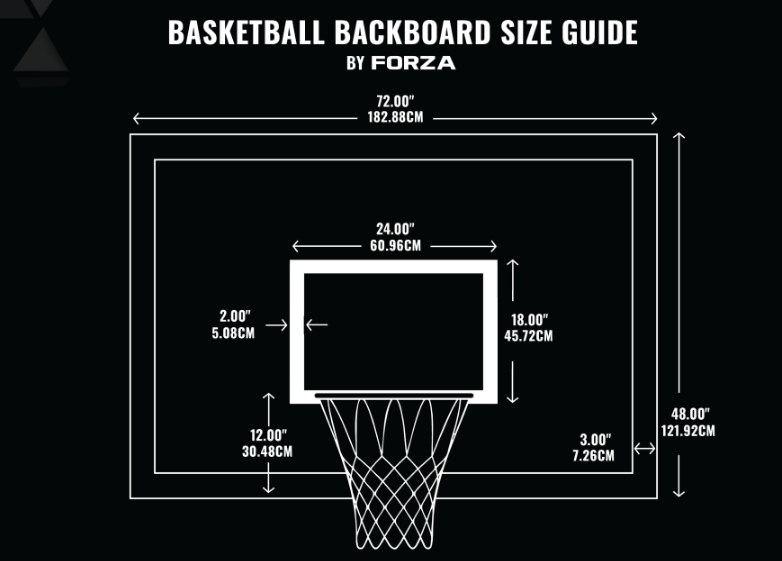Introduction:
When choosing a basketball hoop, one of the most important considerations is the backboard size. Whether you’re installing a hoop in your backyard or upgrading a court, understanding what size backboard is suitable for your needs can enhance your game and ensure optimal performance. But what size backboard for a basketball hoop is right for you? In this article, we’ll break down everything you need to know about basketball hoop backboard sizes.
Why the Right Backboard Size Matters
Backboard size can have a huge impact on how well you play and how much fun you have. Whether you are a beginner, a seasoned player, or even a young athlete, choosing the right size backboard helps ensure good gameplay and longevity of your hoop.
Impact on Gameplay
A larger backboard can increase the accuracy and rebound chances. Smaller boards are more suitable for casual games or kids who are just starting out.
Optimal Performance
For those aiming for serious play or preparing for games that follow regulation standards, size and material matter.
Standard Backboard Sizes
In general, basketball hoop backboards come in a few standard sizes. Let’s look at the most common sizes:
Regulation Size (72 inches)
The official regulation backboard size for professional courts like those used in the NBA is 72 inches wide and 42 inches high. This size provides a balance between being large enough to catch shots and small enough to allow a reasonable level of challenge.
Intermediate and Youth Size (54-60 inches)
For home courts, intermediate-sized backboards, typically 54 inches or 60 inches wide, are quite common. These sizes offer a compromise between regulation size and easier gameplay, ideal for players aiming to improve their skills while still playing in a recreational setting.
Mini Backboards (44 inches and below)
If you’re installing a hoop for younger children or if you have limited space, 44-inch backboards are a great choice. These smaller boards are perfect for younger players and can make the game more accessible.
Choosing the Right Size Based on Skill Level
Your skill level and type of gameplay will influence the backboard size you should opt for. Here’s a breakdown based on skill level:
For Beginners
For those new to the game, a smaller backboard can make it easier to score and have fun without being discouraged. A 44-inch backboard or even smaller is sufficient for kids or first-time players.
For Intermediate Players
If you’re improving your basketball skills and aiming for a more serious game, then a 54-inch backboard is ideal. It mimics real-life game conditions, offering a good mix of challenge and fun.
For Professional or Serious Players
For serious basketball enthusiasts or those aiming to play at a professional level, a 72-inch backboard is the best option. This size matches official standards and allows you to practice as you would in competitive games.

Material of the Backboard: How It Affects Size
Aside from the size of the backboard, material plays a significant role in performance. Let’s explore the most common materials:
Acrylic Backboards
Acrylic backboards are a popular choice for home hoops due to their durability and affordability. They are typically found in 54-inch to 60-inch sizes and offer a similar rebound effect to glass but are more lightweight.
Glass Backboards
Glass backboards are the official material used in professional settings, offering the best rebound quality. Most professional players and those looking for a high-quality game experience prefer 72-inch glass backboards.
Polycarbonate Backboards
Polycarbonate is an excellent choice for a budget-friendly backboard. It’s not as high-performing as glass but offers solid durability for recreational games, often available in 44-inch sizes.
Factors to Consider When Choosing a Backboard Size
When deciding on a backboard size, it’s essential to consider several factors:
Available Space
Make sure your space can accommodate the size of the backboard. Large backboards like the 72-inch model require more space, especially for proper hoop installation. Measure your driveway or court space to ensure it will fit.
Age and Skill Level
As discussed earlier, the backboard size should be based on the player’s age and skill level. A smaller backboard is ideal for younger players, while more advanced players will benefit from a larger size.
Budget
Backboard sizes come with varying price ranges. Smaller backboards are typically more affordable, while larger ones, especially glass ones, can be more expensive.
FAQ Section
Q1: What size backboard do I need for outdoor basketball? For outdoor play, a 54-inch or 60-inch backboard is a popular choice, providing a good balance between size and performance.
Q2: Can I use a 72-inch backboard for a home court? Yes, but make sure you have enough space. A 72-inch backboard is typically for professional courts and may require more space to install.
Q3: How do I install a basketball hoop with a 60-inch backboard? Installation requires proper mounting on a stable structure, such as a pole or wall. Make sure to follow the manufacturer’s instructions for a safe and secure installation.
Q4: Is a glass backboard worth the investment? Yes, especially for serious players. Glass backboards provide superior rebound quality but can be pricier than acrylic or polycarbonate.
Q5: What material is best for a budget-friendly backboard? Polycarbonate backboards are typically the best option for those on a budget. They are durable and affordable.
Q6: Do smaller backboards impact gameplay for adults? Yes, smaller backboards make the game easier, but they don’t provide the same challenge as larger, regulation-sized backboards.
Conclusion:
Choosing the right backboard size is essential for enhancing your basketball experience, whether you’re a beginner or an experienced player. From 44-inch boards for kids to 72-inch professional boards, there’s an ideal size for every level. Consider your space, skill level, and budget when making your decision, and enjoy the game with the perfect setup!

